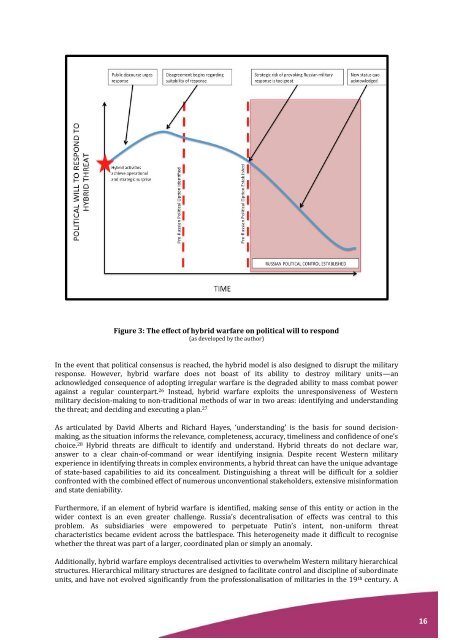Issue No 198 2015
198 2015 Nov_Dec
198 2015 Nov_Dec
You also want an ePaper? Increase the reach of your titles
YUMPU automatically turns print PDFs into web optimized ePapers that Google loves.
Figure 3: The effect of hybrid warfare on political will to respond<br />
(as developed by the author)<br />
In the event that political consensus is reached, the hybrid model is also designed to disrupt the military<br />
response. However, hybrid warfare does not boast of its ability to destroy military units—an<br />
acknowledged consequence of adopting irregular warfare is the degraded ability to mass combat power<br />
against a regular counterpart. 26 Instead, hybrid warfare exploits the unresponsiveness of Western<br />
military decision-making to non-traditional methods of war in two areas: identifying and understanding<br />
the threat; and deciding and executing a plan. 27<br />
As articulated by David Alberts and Richard Hayes, ‘understanding’ is the basis for sound decisionmaking,<br />
as the situation informs the relevance, completeness, accuracy, timeliness and confidence of one’s<br />
choice. 28 Hybrid threats are difficult to identify and understand. Hybrid threats do not declare war,<br />
answer to a clear chain-of-command or wear identifying insignia. Despite recent Western military<br />
experience in identifying threats in complex environments, a hybrid threat can have the unique advantage<br />
of state-based capabilities to aid its concealment. Distinguishing a threat will be difficult for a soldier<br />
confronted with the combined effect of numerous unconventional stakeholders, extensive misinformation<br />
and state deniability.<br />
Furthermore, if an element of hybrid warfare is identified, making sense of this entity or action in the<br />
wider context is an even greater challenge. Russia’s decentralisation of effects was central to this<br />
problem. As subsidiaries were empowered to perpetuate Putin’s intent, non-uniform threat<br />
characteristics became evident across the battlespace. This heterogeneity made it difficult to recognise<br />
whether the threat was part of a larger, coordinated plan or simply an anomaly.<br />
Additionally, hybrid warfare employs decentralised activities to overwhelm Western military hierarchical<br />
structures. Hierarchical military structures are designed to facilitate control and discipline of subordinate<br />
units, and have not evolved significantly from the professionalisation of militaries in the 19 th century. A<br />
16


